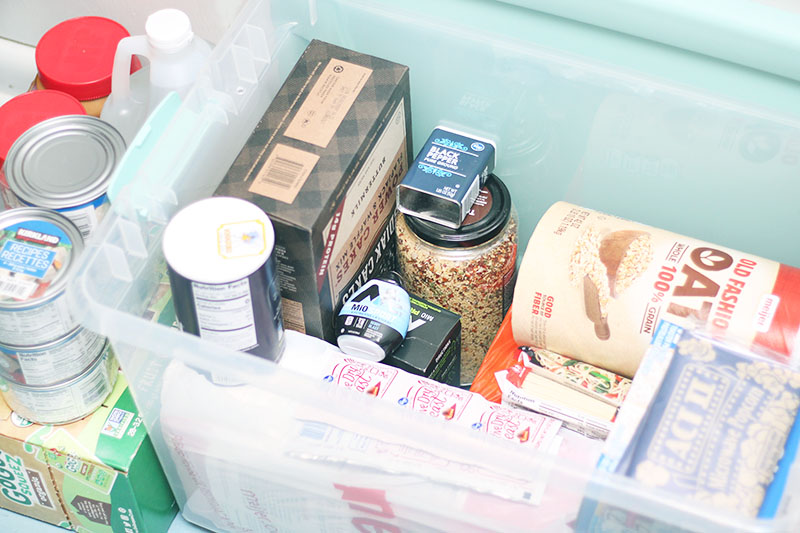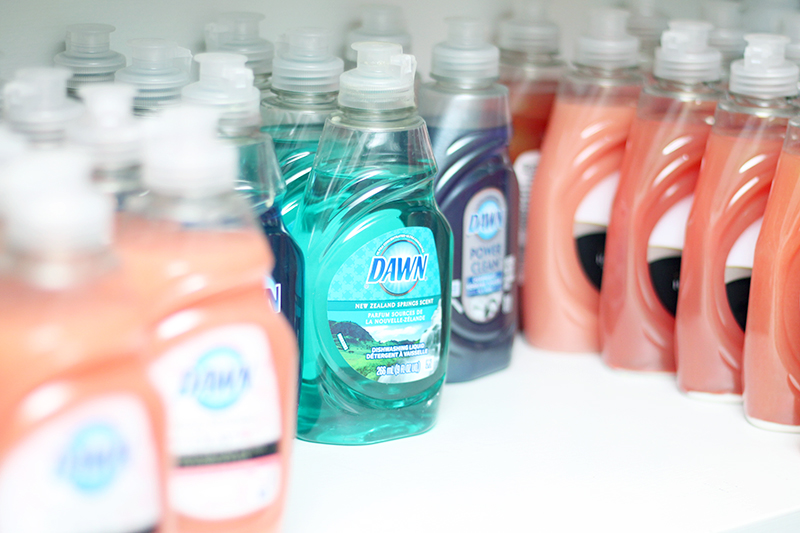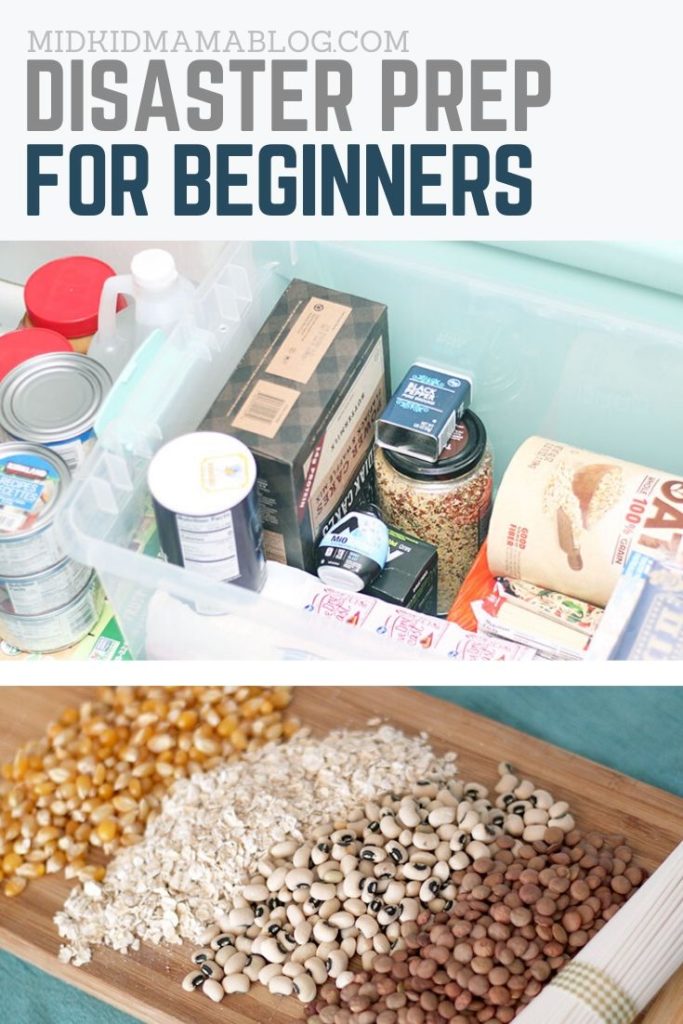Easy Steps to Disaster Preparedness
Everyone preps in one way or another. When you buy toilet paper or laundry soap, you typically buy more than just what you need for the week. You probably store the extra roles of toilet paper in your cabinet and get more before you get to the last roll. In one small way or another, we all buy a little more than we need so we don’t have to go to the store every single day.

But, what if something happened and you couldn’t leave your house for a few days—would you be able to comfortably survive? Do you have the food, water and basic necessities on hand to make things work for even a week or two? There is a reality of natural disasters, diseases, storms and other things occurring at any time and with little-to-no warning.
The current virus threat has schools, workplaces and even whole countries closing down to anything but necessary travel. But I also remember ice storms taking out our power and making it very difficult to travel for over a week when I was a teenager. It happened again when I was in my twenties and living in my own house. There was also the blizzard of ’68 that my parents’ generation will never forget—where the snow was up to the rooftops across our state.
So, are you prepared for the realities of disaster situations?
US Disaster Preparedness Stats
Many people aren’t prepping enough. If something did go wrong, the more people who are prepared to manage their own care for a time, the less emergency services have to rush in with supplies and solutions. If we all had a week or two’s worth of supplies on hand, we could care for ourselves and neighbors that need help.
The last US census reported only about half of American households are storing water. Around 80% of families did report having enough nonperishable foods to last the family for three days. FEMA has stated:
If an earthquake, hurricane, winter storm, or other disaster strikes your community, you might not have access to food, water, and electricity for days or even weeks. By taking some time now to store emergency food and water supplies, you can provide for your entire family.
Back when the ice storms knocked out the power and made it impossible to drive, stores were closed and things were tricky. I remember we had plenty of food, but we shared a friend’s generator so we didn’t lose the food in our refrigerator or have our phone batteries die. We had to have sources of heat, water and cooking, since the power was gone and a boil advisory was in effect for our area. If we would have been down to the last bits of food and supplies before the storm hit unexpectedly, we would have been in a little trouble and had to depend on neighbors and friends for help.
Basic Prepping for Beginners
Prepping and disaster readiness might seem a little out there for many. Perhaps you picture people in off-the-grid underground bunkers with freeze-dried soups and metallic heat-reflecting blankets. But what I’m talking about is scaled back, simple and manageable.
Basic prepping should include necessities you that you are already using in your daily lives for the most part. With basic prepper storage, you want to focus on items that are easy to store, easy to use and have a longer shelf life.
The goal will be to choose items you already use on a weekly, monthly or occasional basis so you can swap them out regularly. You don’t want to buy a special dried soup that you never actually use and it eventually goes bad. You don’t need to waste money on strange foods just because they will last a long time. You can choose items that will be swapped out over time and used naturally in the course of your family’s meal planning.
Easy Snacks
It is a good idea to have foods that can make easy snacks that are fun and filling. Items like Pop Tarts have a very long shelf life, are packaged individually and take no work to prepare (in case of a power outage). Something like pop corn is also fun and filling, but would take power to make, so it works if you just can’t travel. Snacking items can contain veggies, like the fruit and applesauce pouches they have for kids. Try to include as many nutritional snacks as you can in your storage. You want things that last for a while and are easy to store, but many of those items are not going to have a lot of green things in them.
Meal Basics
When you are planning your storage, think about what you need to make a good meal. Most of our meals include vegetables, a starch or carb and then meat. When you are storing food, you want a mixture of these items. It is easy to store a lot of frozen meat, dried noodles and very few vegetables if you aren’t thinking about it much. You don’t want to get overly heavy on the frozen or canned storage because canned items contain more sodium and frozen foods won’t last as long if the power goes out.
Some items, like rice, will require water and a heat source to prepare. While you will have power in many scenarios, you can’t always count on it. A mix of raw and cooked foods is helpful so you are prepared with or without power.
Some items, like noodles, are easy to store, but fairly pointless if you don’t have other things (like sauce or meat) to go well with them. So, when prepping, try to think about whole meals. Try to choose items that can be used in more than one way. Oatmeal, rice and peanut butter are foods dogs can eat too, for example. Canned chicken can be used for sandwiches, soups or on any kind of noodles without any work to thaw or cook it.
Pantry Food Storage
Pantry foods are dried, canned or packaged foods that don’t need to be kept in a specific climate. Preferably your pantry food storage will be a place other than your normal kitchen pantry and will be on the cool/dark side. You can use a basement closet, linen closet or even a big tote under a bed for this. The goal with the pantry storage is to have a few items on hand that you will use over time and replace with new storage items. How many pantry items you keep on hand will vary based on how much space you want to allot to your storage and how much extra food you want to keep on hand.

Get a locking plastic storage tote for items that could easily attract pests. You don’t want to have mice or bugs getting into your storage and invading your home because food is too accessible. A large locking storage tote will keep your items dry, collected into a neat space and safe from pests. Items that are well package in jars or cans will not need to be included in the tote for storage.
Check dates of everything you are planning to store. Ideally, your items will be good for a year or more. Some items, like crackers, don’t have long dates before they start to go stale. You want to give yourself room in case you forget to swap something out, so you want to avoid keeping any short dates in your pantry food storage. Checking the dates will give you an idea of roughly how long you have until you need to use it. If Pop Tarts aren’t really part of your regular family diet, then you know you have a whole year or so before you need to buy another box and use the current storage ones for a fun snack.
Examples of Pantry Food Storage:
- Popcorn
- Pop Tarts
- Snack pouches and/or baby food
- Rice
- Oatmeal
- Couscous
- Quinoa
- Nuts and seeds
- Dried fruit
- Ramen noodles
- Spaghetti/rotini/macaroni noodles
- Egg noodles
- Canned meat, veggies and fruit
- Spaghetti sauce
- Peanut butter
- Honey
- Pancake mix
- Syrup
- Salt/pepper/spices (like 1 or 2)
- Oil
- Flour and yeast (if you like to bake)
- Water flavoring (preferably with vitamins or electrolytes)
- Coffee
Frozen Food Storage
How many things you can store in the freezer is going to largely depend on how much freezer space you have. It’s really nice when you have a separate refrigerator/freezer or deep freezer for food storage because it will give you a lot more space. But even if you don’t, just a few choice items can be stored in the back of your regular freezer in case of emergency.
Examples of Frozen Food Storage:
- Raw or cooked meat
- Lunchmeat
- Sausages and Hotdogs
- Peas and other bagged veggies
- Bread (double bag to avoid freezer burn)
- Easy dinners (pot pies, pizza, burgers, chicken nuggets, burritos, full meals)
- Cheese (including string or sliced cheese)
- Broth (I prefer to make my own and freeze it)
- Homemade meals (chili, quiche, meatloaf, soup, stews)
- Sauces
- Fruit (berries, peaches, pineapples and cherries freeze well)
Water Storage
Occasionally a disaster situation could lead to issues with the water filtration system. There have certainly been boil advisories here before. Keeping water on hand is a good way to have a clean source of drinking water in case of emergency. FEMA recommends keeping a two-week supply of drinking water for every person in the home (that is 7-14 gallons per person!).
While the average adult will only require about a half-gallon per day, sick people, children and pregnant women will likely require more, especially in a hot environment.
“Having an ample supply of clean water is a top priority in an emergency.”
-FEMA
While there are ways to store your own water, the process does involve the right amount of chlorinated bleach. Purchasing commercially bottled water (preferably gallon size or larger to reduce packaging and make storage easier) ensures you have a safe supply of clean drinking water that will last indefinitely.
Hygienic Supplies
Different scenarios (natural disasters where you can’t travel, power outages, national pandemic) will lead to additional items you will want to keep on hand. Cleaning supplies, soap and cooking fuel are examples of things you might want to keep on hand that won’t go bad for a very long time. Medications and batteries are items you will want to swap out every time you buy more for regular use.

Here is a list of things you may or may not want to have on hand. Choose things that you would desperately need if you lost power, had to travel, couldn’t travel or another possible emergency scenario arrived.
- Cleaners
- Soap
- Medication
- Hygiene products
- Batteries
- Skillet/firewood/fuel
- Toilet Paper
- Detergent/bleach
- First aid items
- Rubbing alcohol/witch hazel
- Diapers and wipes
- Unscented candles/flashlight
- Emergency documents
Low Budget Prepping
A lot of us don’t have a big weekly budget. There isn’t much room for building up a stockpile of items. When you are trying to buy extras for disaster prep, it can start out cheap and small. You don’t need to overwhelm your budget to create a pantry buffer. Just like a savings account or rainy day fund in the bank, prepping is best when it builds up slow and steady.
Add More Over Time
Don’t rush out and buy a huge stash unless you have extra cash on hand. You can start small and build up slowly. With just five dollars, you can buy a large box of Ramen noodles, a can of chicken and a couple gallons of water. If you keep buying a few additional items each trip, you will have a couple extra weeks of food in no time.
Plan to Swap Out
It is incredibly important when you are on a low budget that you swap your items out. Plan to stock up on items you already use that you will continue to buy. Each item you purchase, you will put it in your storage stockpile and use the stockpile item.
Check Dates
You might really be surprised at how long some things last while others expire quickly. You want to check dates so you know you can use items before they go bad. If PopTarts last a year, you know you can plan to eat them at any point in the year and you don’t need to plan on them being part of the weekly menu. Other items, like some crackers and noodles, might have a much shorter shelf life, so checking the dates will give you an idea of whether or not an item is good to store. If you use those items every week, then you can store them.
Start Small
Don’t get overwhelmed. Start with just a couple of days of extra food and expand over time Think about how you are going to use your items to create meals. This will help you stay organized and not get into a hoarding situation where you have a lot of items that don’t really work together.
Keep Pests in Mind
In order to protect some items, you will want to store them carefully. While jars of peanut butter or cans of tuna are safe from pests, flour, chocolate and oatmeal are examples of items that can attract pests. From mice to weevils, there are all kinds of things that could be attracted to your stockpile. When items are stored away from your normal kitchen stash, they may be more accessible to invaders and you may not notice as quickly. Store items that could be attractive to bugs and rodents (or pets!) somewhere safe, like in a locked plastic bin.
View Storage as Zero
When you get to a place you feel comfortable with your stockpile, you want to count it as your baseline or “zero.” That means, you don’t dip into it unless you are facing an emergency. You definitely want to swap out items as you buy new ones, but you don’t want to use those items before you have the new ones to swap out. Keeping it in a place separate from your normal pantry or freezer storage for every day use will also help with that separation mentality.
Start a Garden
To help out with your storage, grocery bill and skills, start a garden! While many think of gardening as a hobby, growing vegetables can be tricky but leads to a lot of value. A garden doesn’t necessarily seem like part of disaster preparedness, but knowing how to grow your own food is an important skill.
Growing, harvesting, preserving and saving seeds for the next year are all things that many people know little about. Yet, if something went wrong with the food supply chain, it would be a valuable skill. And, on top of that, you save money while controlling the quality of your food (you can avoid pesticides and soil quality, for example).
Overall, it is important to save up items in case of emergency. Don’t wait until things go wrong to start thinking about potential disaster scenarios. If you want to listen to meal prep ideas, you can check out this podcast:

